Role of WordPress Social Media Tool in Education: A Report
VerifiedAdded on 2023/04/19
|16
|4788
|138
Report
AI Summary
This report delves into the role of WordPress as a social media tool within the educational landscape. It begins with an introduction outlining the use of social media in education and poses a research question focused on the implementation of WordPress to enhance learning outcomes. The report then explores the educational theory and concept of media projects, specifically examining the benefits of WordPress for both students and teachers, highlighting features like user-friendly interfaces, mobile compatibility, and impressive publishing tools. The design of the media project is discussed, along with a justification for the topic choice and identification of the target group. The report analyzes both the positive and negative aspects of using WordPress, such as ease of use versus potential layout customization challenges and hacking risks. It also emphasizes how WordPress supports teacher pedagogy and student learning, facilitating online learning communities and enabling communication. The report aims to determine teachers' attitudes toward social media tools in the classroom and examines media pedagogical competences and their role in integrating digital technologies for teaching and learning.
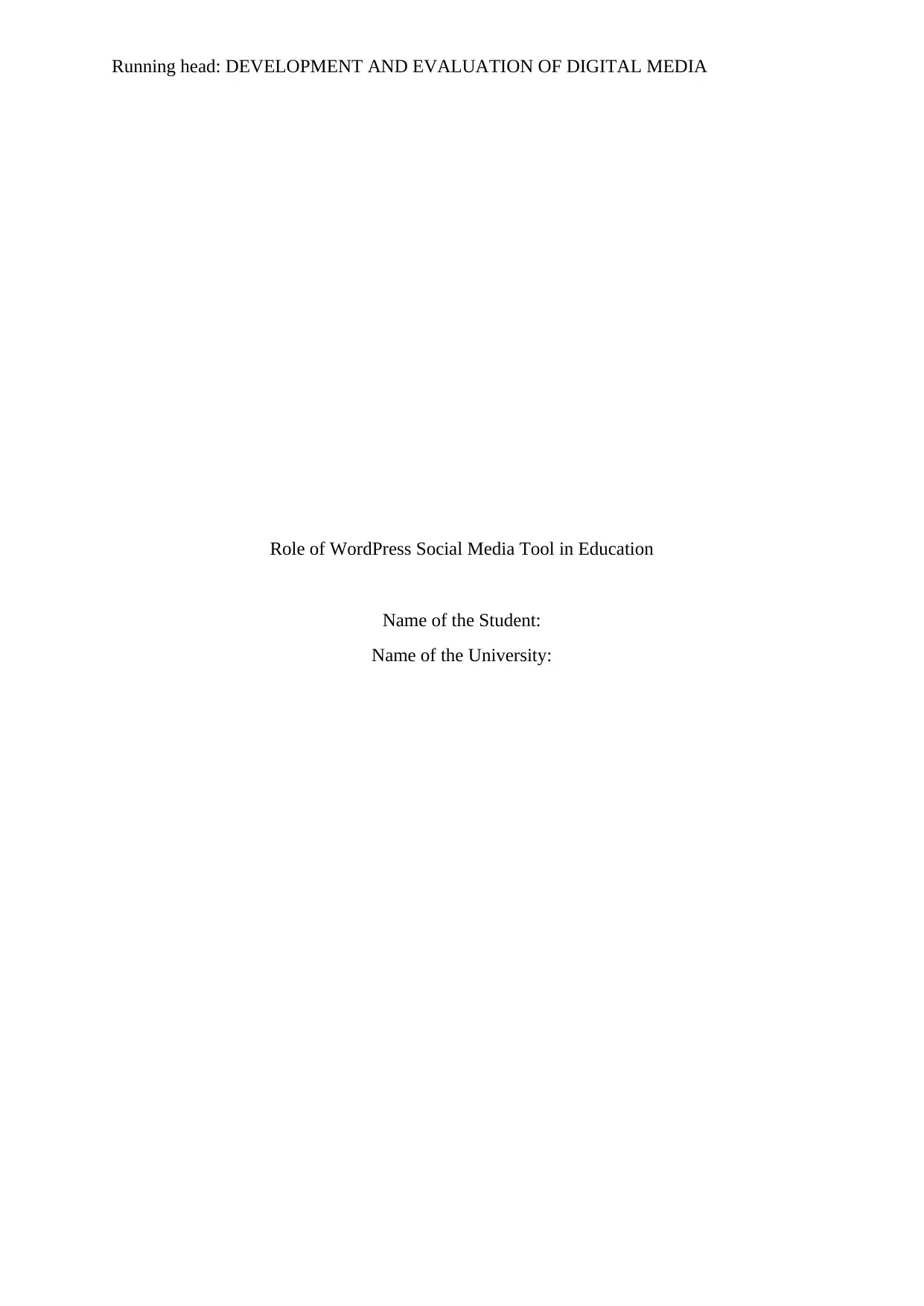
Running head: DEVELOPMENT AND EVALUATION OF DIGITAL MEDIA
Role of WordPress Social Media Tool in Education
Name of the Student:
Name of the University:
Role of WordPress Social Media Tool in Education
Name of the Student:
Name of the University:
Paraphrase This Document
Need a fresh take? Get an instant paraphrase of this document with our AI Paraphraser
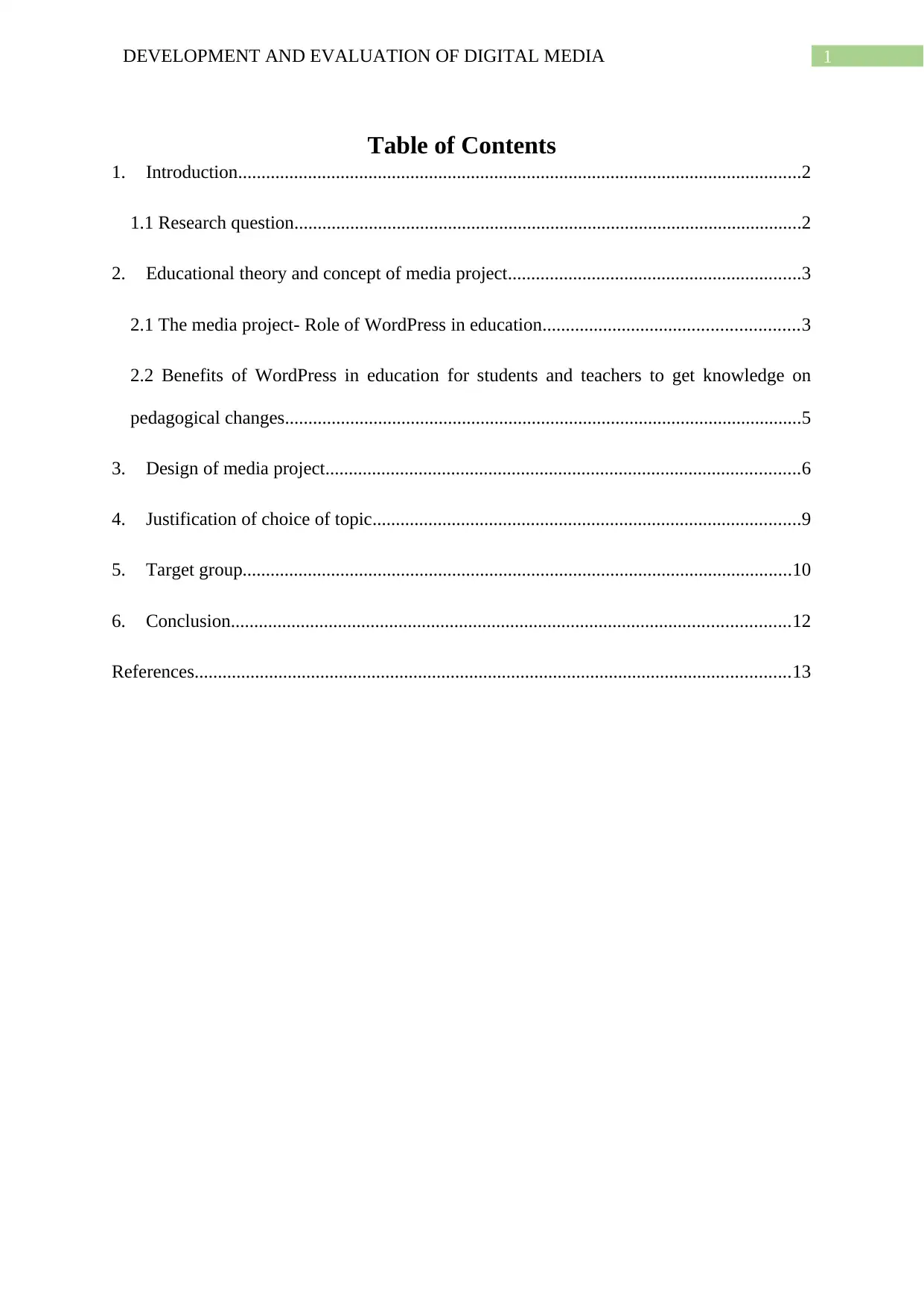
1DEVELOPMENT AND EVALUATION OF DIGITAL MEDIA
Table of Contents
1. Introduction.........................................................................................................................2
1.1 Research question.............................................................................................................2
2. Educational theory and concept of media project...............................................................3
2.1 The media project- Role of WordPress in education.......................................................3
2.2 Benefits of WordPress in education for students and teachers to get knowledge on
pedagogical changes...............................................................................................................5
3. Design of media project......................................................................................................6
4. Justification of choice of topic............................................................................................9
5. Target group......................................................................................................................10
6. Conclusion........................................................................................................................12
References................................................................................................................................13
Table of Contents
1. Introduction.........................................................................................................................2
1.1 Research question.............................................................................................................2
2. Educational theory and concept of media project...............................................................3
2.1 The media project- Role of WordPress in education.......................................................3
2.2 Benefits of WordPress in education for students and teachers to get knowledge on
pedagogical changes...............................................................................................................5
3. Design of media project......................................................................................................6
4. Justification of choice of topic............................................................................................9
5. Target group......................................................................................................................10
6. Conclusion........................................................................................................................12
References................................................................................................................................13
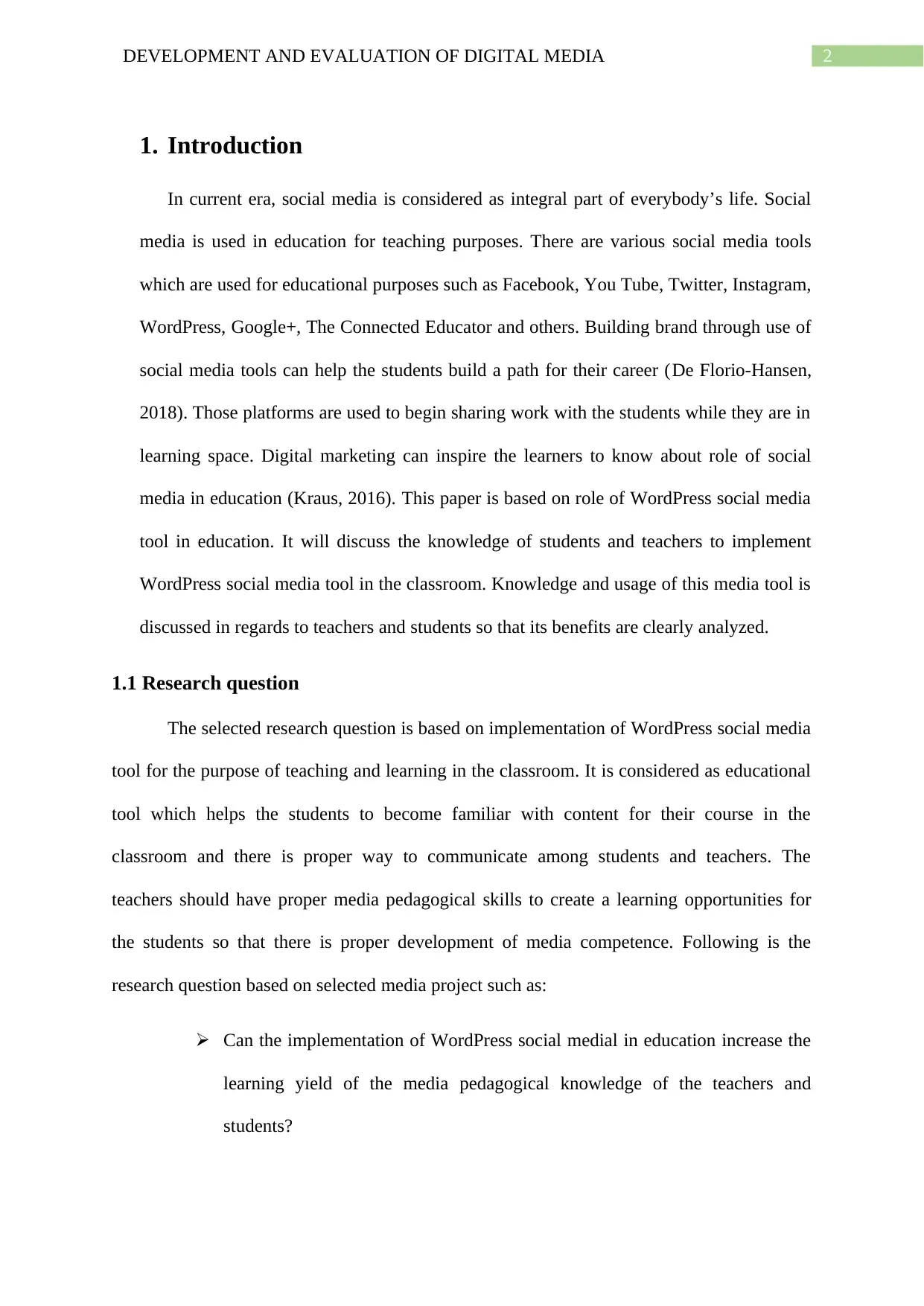
2DEVELOPMENT AND EVALUATION OF DIGITAL MEDIA
1. Introduction
In current era, social media is considered as integral part of everybody’s life. Social
media is used in education for teaching purposes. There are various social media tools
which are used for educational purposes such as Facebook, You Tube, Twitter, Instagram,
WordPress, Google+, The Connected Educator and others. Building brand through use of
social media tools can help the students build a path for their career (De Florio-Hansen,
2018). Those platforms are used to begin sharing work with the students while they are in
learning space. Digital marketing can inspire the learners to know about role of social
media in education (Kraus, 2016). This paper is based on role of WordPress social media
tool in education. It will discuss the knowledge of students and teachers to implement
WordPress social media tool in the classroom. Knowledge and usage of this media tool is
discussed in regards to teachers and students so that its benefits are clearly analyzed.
1.1 Research question
The selected research question is based on implementation of WordPress social media
tool for the purpose of teaching and learning in the classroom. It is considered as educational
tool which helps the students to become familiar with content for their course in the
classroom and there is proper way to communicate among students and teachers. The
teachers should have proper media pedagogical skills to create a learning opportunities for
the students so that there is proper development of media competence. Following is the
research question based on selected media project such as:
Can the implementation of WordPress social medial in education increase the
learning yield of the media pedagogical knowledge of the teachers and
students?
1. Introduction
In current era, social media is considered as integral part of everybody’s life. Social
media is used in education for teaching purposes. There are various social media tools
which are used for educational purposes such as Facebook, You Tube, Twitter, Instagram,
WordPress, Google+, The Connected Educator and others. Building brand through use of
social media tools can help the students build a path for their career (De Florio-Hansen,
2018). Those platforms are used to begin sharing work with the students while they are in
learning space. Digital marketing can inspire the learners to know about role of social
media in education (Kraus, 2016). This paper is based on role of WordPress social media
tool in education. It will discuss the knowledge of students and teachers to implement
WordPress social media tool in the classroom. Knowledge and usage of this media tool is
discussed in regards to teachers and students so that its benefits are clearly analyzed.
1.1 Research question
The selected research question is based on implementation of WordPress social media
tool for the purpose of teaching and learning in the classroom. It is considered as educational
tool which helps the students to become familiar with content for their course in the
classroom and there is proper way to communicate among students and teachers. The
teachers should have proper media pedagogical skills to create a learning opportunities for
the students so that there is proper development of media competence. Following is the
research question based on selected media project such as:
Can the implementation of WordPress social medial in education increase the
learning yield of the media pedagogical knowledge of the teachers and
students?
⊘ This is a preview!⊘
Do you want full access?
Subscribe today to unlock all pages.

Trusted by 1+ million students worldwide
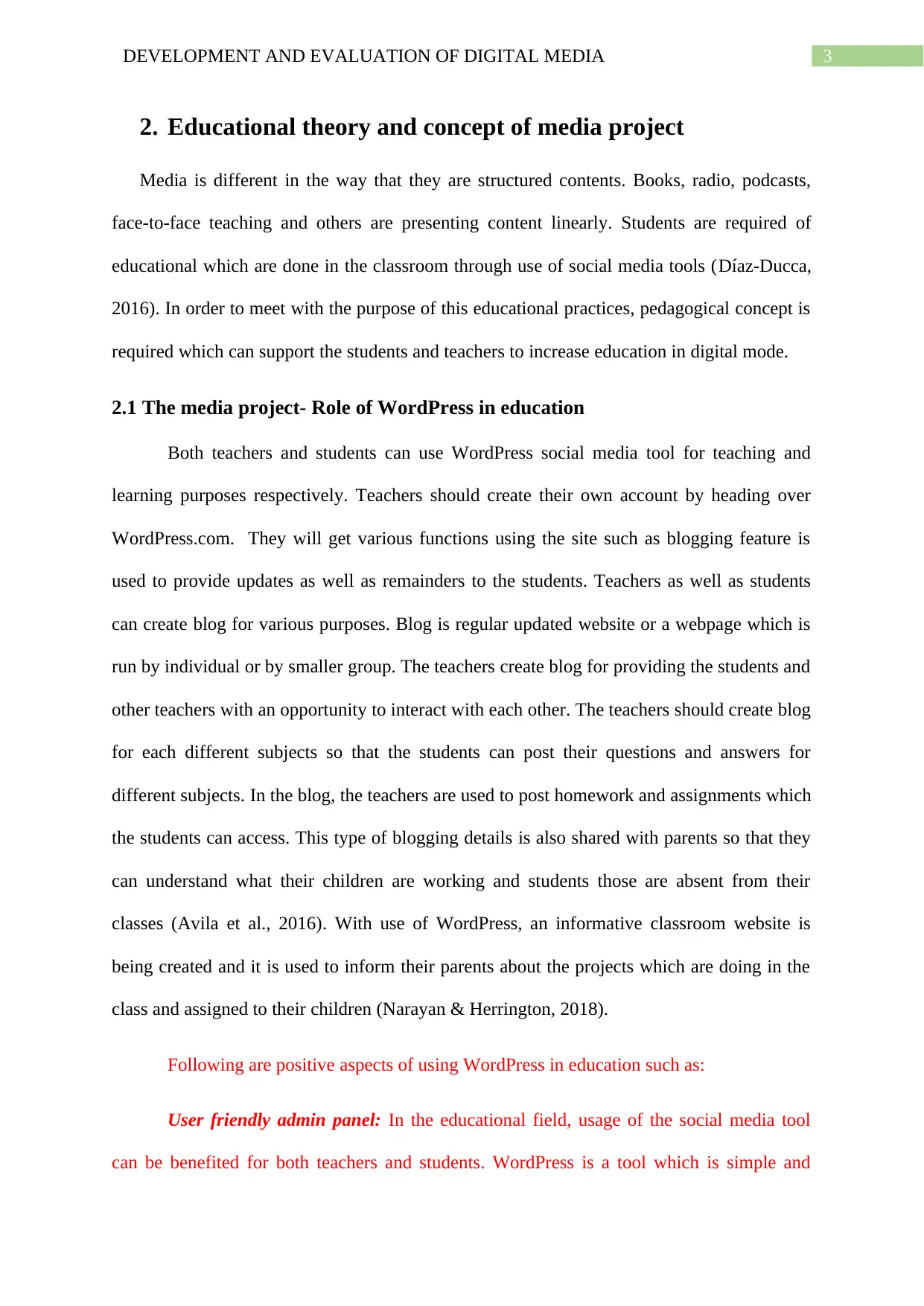
3DEVELOPMENT AND EVALUATION OF DIGITAL MEDIA
2. Educational theory and concept of media project
Media is different in the way that they are structured contents. Books, radio, podcasts,
face-to-face teaching and others are presenting content linearly. Students are required of
educational which are done in the classroom through use of social media tools (Díaz-Ducca,
2016). In order to meet with the purpose of this educational practices, pedagogical concept is
required which can support the students and teachers to increase education in digital mode.
2.1 The media project- Role of WordPress in education
Both teachers and students can use WordPress social media tool for teaching and
learning purposes respectively. Teachers should create their own account by heading over
WordPress.com. They will get various functions using the site such as blogging feature is
used to provide updates as well as remainders to the students. Teachers as well as students
can create blog for various purposes. Blog is regular updated website or a webpage which is
run by individual or by smaller group. The teachers create blog for providing the students and
other teachers with an opportunity to interact with each other. The teachers should create blog
for each different subjects so that the students can post their questions and answers for
different subjects. In the blog, the teachers are used to post homework and assignments which
the students can access. This type of blogging details is also shared with parents so that they
can understand what their children are working and students those are absent from their
classes (Avila et al., 2016). With use of WordPress, an informative classroom website is
being created and it is used to inform their parents about the projects which are doing in the
class and assigned to their children (Narayan & Herrington, 2018).
Following are positive aspects of using WordPress in education such as:
User friendly admin panel: In the educational field, usage of the social media tool
can be benefited for both teachers and students. WordPress is a tool which is simple and
2. Educational theory and concept of media project
Media is different in the way that they are structured contents. Books, radio, podcasts,
face-to-face teaching and others are presenting content linearly. Students are required of
educational which are done in the classroom through use of social media tools (Díaz-Ducca,
2016). In order to meet with the purpose of this educational practices, pedagogical concept is
required which can support the students and teachers to increase education in digital mode.
2.1 The media project- Role of WordPress in education
Both teachers and students can use WordPress social media tool for teaching and
learning purposes respectively. Teachers should create their own account by heading over
WordPress.com. They will get various functions using the site such as blogging feature is
used to provide updates as well as remainders to the students. Teachers as well as students
can create blog for various purposes. Blog is regular updated website or a webpage which is
run by individual or by smaller group. The teachers create blog for providing the students and
other teachers with an opportunity to interact with each other. The teachers should create blog
for each different subjects so that the students can post their questions and answers for
different subjects. In the blog, the teachers are used to post homework and assignments which
the students can access. This type of blogging details is also shared with parents so that they
can understand what their children are working and students those are absent from their
classes (Avila et al., 2016). With use of WordPress, an informative classroom website is
being created and it is used to inform their parents about the projects which are doing in the
class and assigned to their children (Narayan & Herrington, 2018).
Following are positive aspects of using WordPress in education such as:
User friendly admin panel: In the educational field, usage of the social media tool
can be benefited for both teachers and students. WordPress is a tool which is simple and
Paraphrase This Document
Need a fresh take? Get an instant paraphrase of this document with our AI Paraphraser
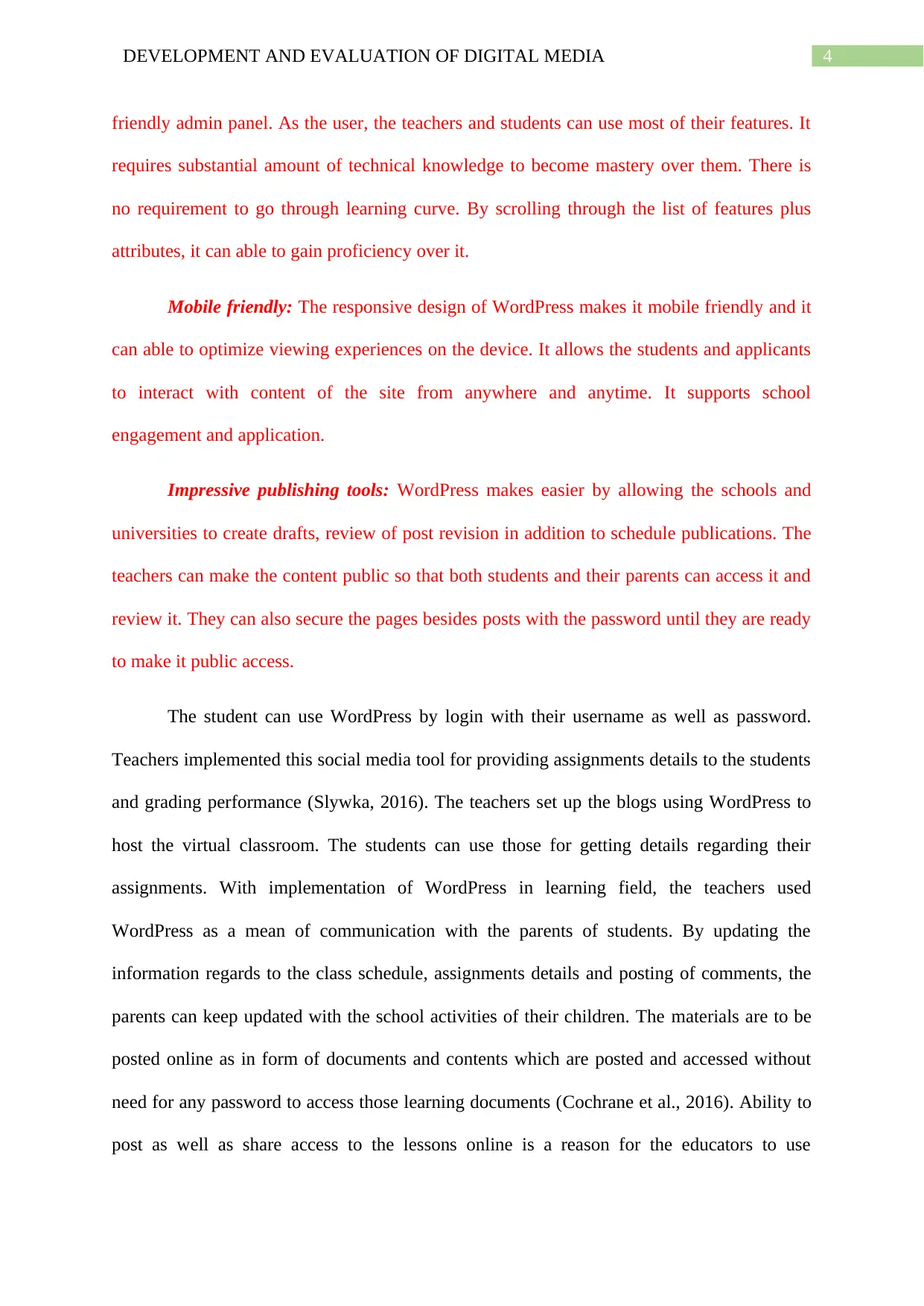
4DEVELOPMENT AND EVALUATION OF DIGITAL MEDIA
friendly admin panel. As the user, the teachers and students can use most of their features. It
requires substantial amount of technical knowledge to become mastery over them. There is
no requirement to go through learning curve. By scrolling through the list of features plus
attributes, it can able to gain proficiency over it.
Mobile friendly: The responsive design of WordPress makes it mobile friendly and it
can able to optimize viewing experiences on the device. It allows the students and applicants
to interact with content of the site from anywhere and anytime. It supports school
engagement and application.
Impressive publishing tools: WordPress makes easier by allowing the schools and
universities to create drafts, review of post revision in addition to schedule publications. The
teachers can make the content public so that both students and their parents can access it and
review it. They can also secure the pages besides posts with the password until they are ready
to make it public access.
The student can use WordPress by login with their username as well as password.
Teachers implemented this social media tool for providing assignments details to the students
and grading performance (Slywka, 2016). The teachers set up the blogs using WordPress to
host the virtual classroom. The students can use those for getting details regarding their
assignments. With implementation of WordPress in learning field, the teachers used
WordPress as a mean of communication with the parents of students. By updating the
information regards to the class schedule, assignments details and posting of comments, the
parents can keep updated with the school activities of their children. The materials are to be
posted online as in form of documents and contents which are posted and accessed without
need for any password to access those learning documents (Cochrane et al., 2016). Ability to
post as well as share access to the lessons online is a reason for the educators to use
friendly admin panel. As the user, the teachers and students can use most of their features. It
requires substantial amount of technical knowledge to become mastery over them. There is
no requirement to go through learning curve. By scrolling through the list of features plus
attributes, it can able to gain proficiency over it.
Mobile friendly: The responsive design of WordPress makes it mobile friendly and it
can able to optimize viewing experiences on the device. It allows the students and applicants
to interact with content of the site from anywhere and anytime. It supports school
engagement and application.
Impressive publishing tools: WordPress makes easier by allowing the schools and
universities to create drafts, review of post revision in addition to schedule publications. The
teachers can make the content public so that both students and their parents can access it and
review it. They can also secure the pages besides posts with the password until they are ready
to make it public access.
The student can use WordPress by login with their username as well as password.
Teachers implemented this social media tool for providing assignments details to the students
and grading performance (Slywka, 2016). The teachers set up the blogs using WordPress to
host the virtual classroom. The students can use those for getting details regarding their
assignments. With implementation of WordPress in learning field, the teachers used
WordPress as a mean of communication with the parents of students. By updating the
information regards to the class schedule, assignments details and posting of comments, the
parents can keep updated with the school activities of their children. The materials are to be
posted online as in form of documents and contents which are posted and accessed without
need for any password to access those learning documents (Cochrane et al., 2016). Ability to
post as well as share access to the lessons online is a reason for the educators to use
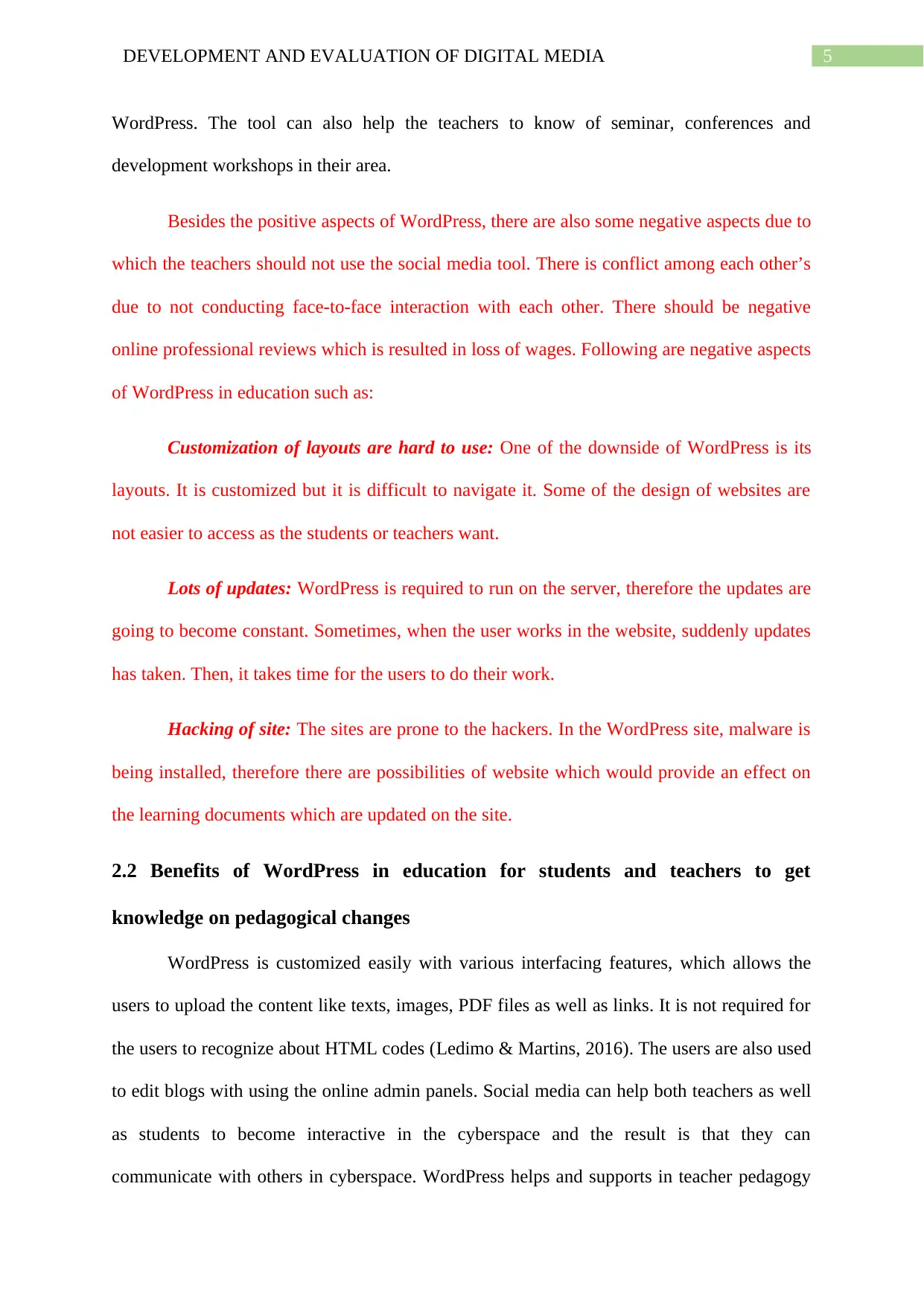
5DEVELOPMENT AND EVALUATION OF DIGITAL MEDIA
WordPress. The tool can also help the teachers to know of seminar, conferences and
development workshops in their area.
Besides the positive aspects of WordPress, there are also some negative aspects due to
which the teachers should not use the social media tool. There is conflict among each other’s
due to not conducting face-to-face interaction with each other. There should be negative
online professional reviews which is resulted in loss of wages. Following are negative aspects
of WordPress in education such as:
Customization of layouts are hard to use: One of the downside of WordPress is its
layouts. It is customized but it is difficult to navigate it. Some of the design of websites are
not easier to access as the students or teachers want.
Lots of updates: WordPress is required to run on the server, therefore the updates are
going to become constant. Sometimes, when the user works in the website, suddenly updates
has taken. Then, it takes time for the users to do their work.
Hacking of site: The sites are prone to the hackers. In the WordPress site, malware is
being installed, therefore there are possibilities of website which would provide an effect on
the learning documents which are updated on the site.
2.2 Benefits of WordPress in education for students and teachers to get
knowledge on pedagogical changes
WordPress is customized easily with various interfacing features, which allows the
users to upload the content like texts, images, PDF files as well as links. It is not required for
the users to recognize about HTML codes (Ledimo & Martins, 2016). The users are also used
to edit blogs with using the online admin panels. Social media can help both teachers as well
as students to become interactive in the cyberspace and the result is that they can
communicate with others in cyberspace. WordPress helps and supports in teacher pedagogy
WordPress. The tool can also help the teachers to know of seminar, conferences and
development workshops in their area.
Besides the positive aspects of WordPress, there are also some negative aspects due to
which the teachers should not use the social media tool. There is conflict among each other’s
due to not conducting face-to-face interaction with each other. There should be negative
online professional reviews which is resulted in loss of wages. Following are negative aspects
of WordPress in education such as:
Customization of layouts are hard to use: One of the downside of WordPress is its
layouts. It is customized but it is difficult to navigate it. Some of the design of websites are
not easier to access as the students or teachers want.
Lots of updates: WordPress is required to run on the server, therefore the updates are
going to become constant. Sometimes, when the user works in the website, suddenly updates
has taken. Then, it takes time for the users to do their work.
Hacking of site: The sites are prone to the hackers. In the WordPress site, malware is
being installed, therefore there are possibilities of website which would provide an effect on
the learning documents which are updated on the site.
2.2 Benefits of WordPress in education for students and teachers to get
knowledge on pedagogical changes
WordPress is customized easily with various interfacing features, which allows the
users to upload the content like texts, images, PDF files as well as links. It is not required for
the users to recognize about HTML codes (Ledimo & Martins, 2016). The users are also used
to edit blogs with using the online admin panels. Social media can help both teachers as well
as students to become interactive in the cyberspace and the result is that they can
communicate with others in cyberspace. WordPress helps and supports in teacher pedagogy
⊘ This is a preview!⊘
Do you want full access?
Subscribe today to unlock all pages.

Trusted by 1+ million students worldwide
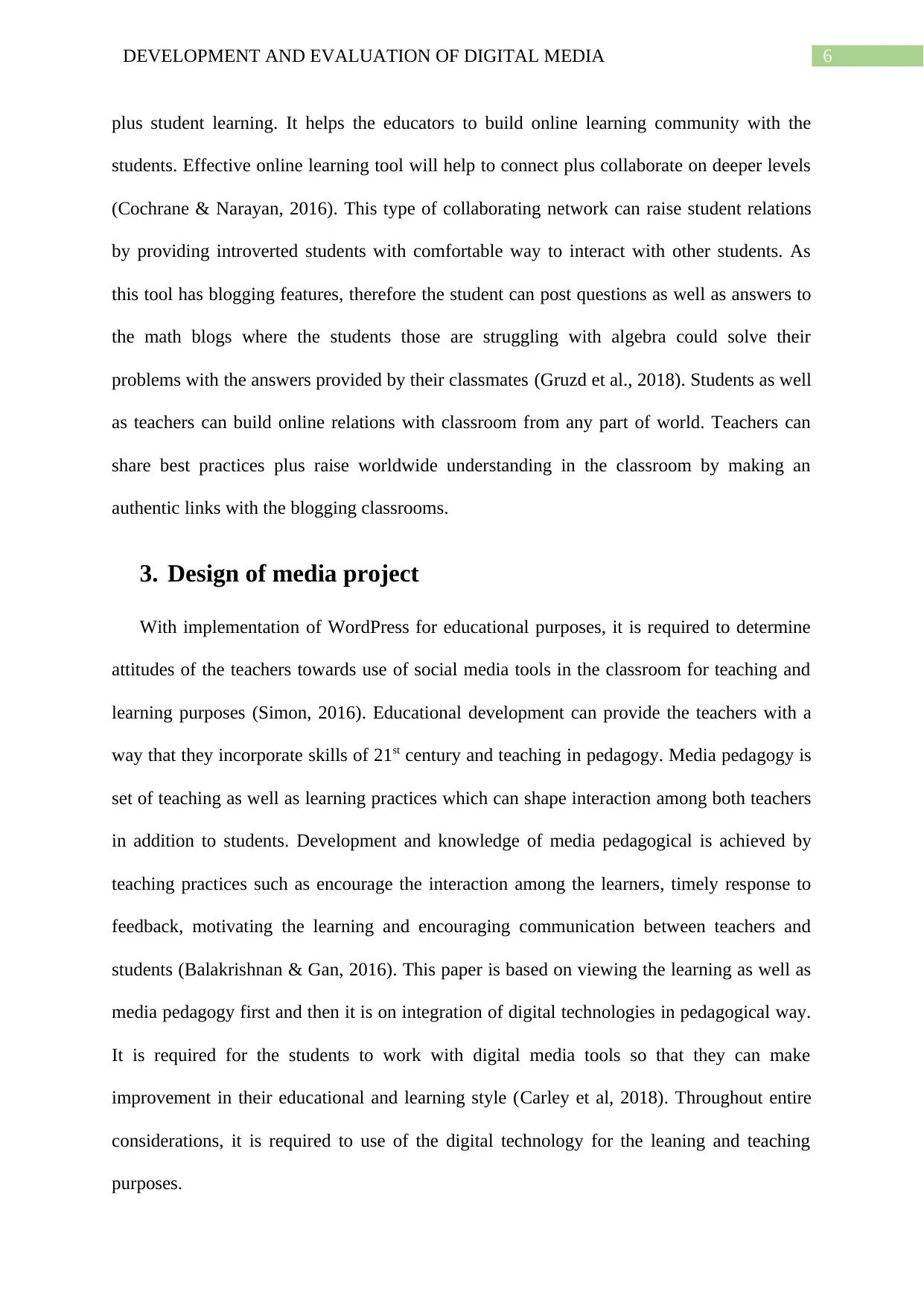
6DEVELOPMENT AND EVALUATION OF DIGITAL MEDIA
plus student learning. It helps the educators to build online learning community with the
students. Effective online learning tool will help to connect plus collaborate on deeper levels
(Cochrane & Narayan, 2016). This type of collaborating network can raise student relations
by providing introverted students with comfortable way to interact with other students. As
this tool has blogging features, therefore the student can post questions as well as answers to
the math blogs where the students those are struggling with algebra could solve their
problems with the answers provided by their classmates (Gruzd et al., 2018). Students as well
as teachers can build online relations with classroom from any part of world. Teachers can
share best practices plus raise worldwide understanding in the classroom by making an
authentic links with the blogging classrooms.
3. Design of media project
With implementation of WordPress for educational purposes, it is required to determine
attitudes of the teachers towards use of social media tools in the classroom for teaching and
learning purposes (Simon, 2016). Educational development can provide the teachers with a
way that they incorporate skills of 21st century and teaching in pedagogy. Media pedagogy is
set of teaching as well as learning practices which can shape interaction among both teachers
in addition to students. Development and knowledge of media pedagogical is achieved by
teaching practices such as encourage the interaction among the learners, timely response to
feedback, motivating the learning and encouraging communication between teachers and
students (Balakrishnan & Gan, 2016). This paper is based on viewing the learning as well as
media pedagogy first and then it is on integration of digital technologies in pedagogical way.
It is required for the students to work with digital media tools so that they can make
improvement in their educational and learning style (Carley et al, 2018). Throughout entire
considerations, it is required to use of the digital technology for the leaning and teaching
purposes.
plus student learning. It helps the educators to build online learning community with the
students. Effective online learning tool will help to connect plus collaborate on deeper levels
(Cochrane & Narayan, 2016). This type of collaborating network can raise student relations
by providing introverted students with comfortable way to interact with other students. As
this tool has blogging features, therefore the student can post questions as well as answers to
the math blogs where the students those are struggling with algebra could solve their
problems with the answers provided by their classmates (Gruzd et al., 2018). Students as well
as teachers can build online relations with classroom from any part of world. Teachers can
share best practices plus raise worldwide understanding in the classroom by making an
authentic links with the blogging classrooms.
3. Design of media project
With implementation of WordPress for educational purposes, it is required to determine
attitudes of the teachers towards use of social media tools in the classroom for teaching and
learning purposes (Simon, 2016). Educational development can provide the teachers with a
way that they incorporate skills of 21st century and teaching in pedagogy. Media pedagogy is
set of teaching as well as learning practices which can shape interaction among both teachers
in addition to students. Development and knowledge of media pedagogical is achieved by
teaching practices such as encourage the interaction among the learners, timely response to
feedback, motivating the learning and encouraging communication between teachers and
students (Balakrishnan & Gan, 2016). This paper is based on viewing the learning as well as
media pedagogy first and then it is on integration of digital technologies in pedagogical way.
It is required for the students to work with digital media tools so that they can make
improvement in their educational and learning style (Carley et al, 2018). Throughout entire
considerations, it is required to use of the digital technology for the leaning and teaching
purposes.
Paraphrase This Document
Need a fresh take? Get an instant paraphrase of this document with our AI Paraphraser
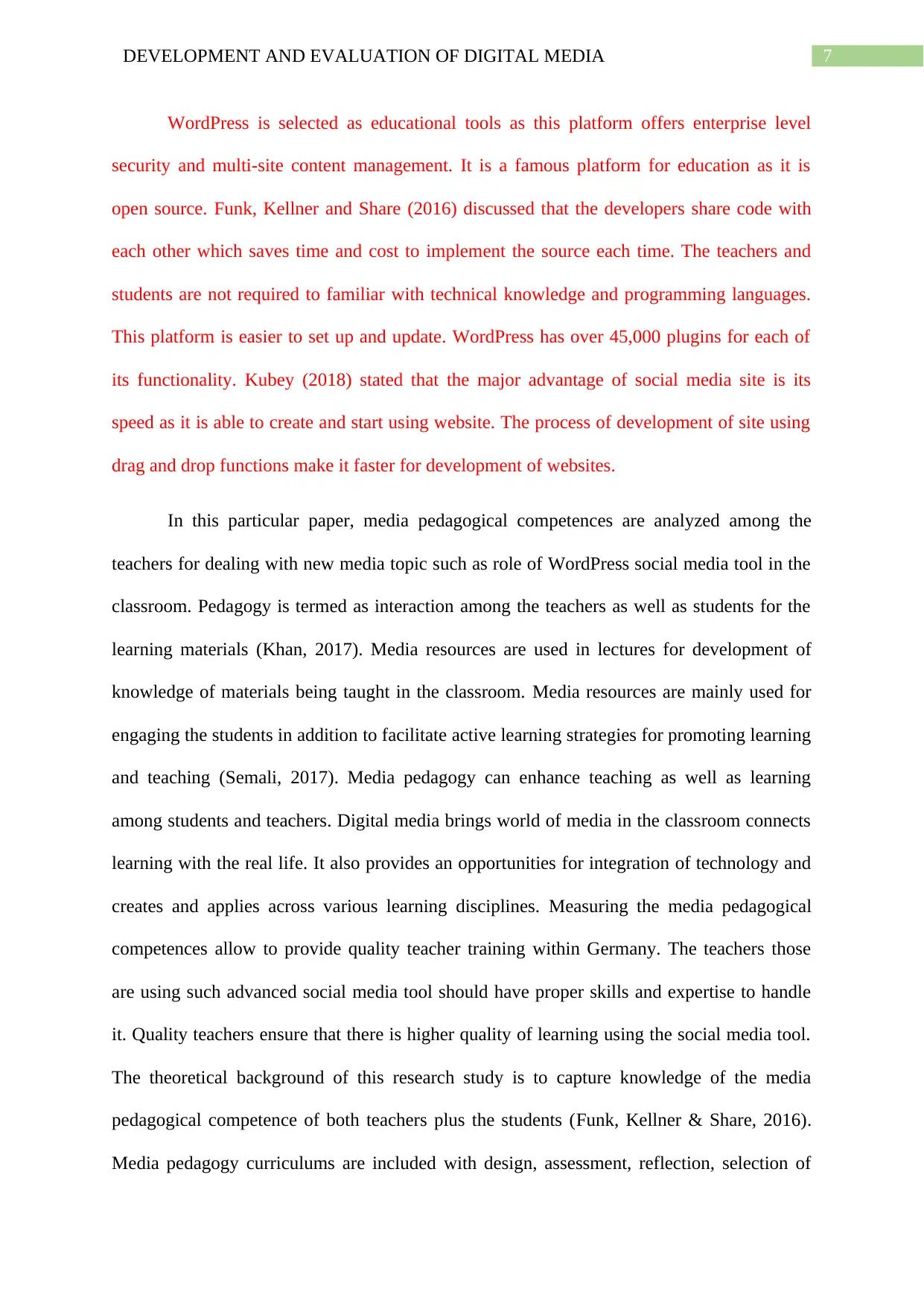
7DEVELOPMENT AND EVALUATION OF DIGITAL MEDIA
WordPress is selected as educational tools as this platform offers enterprise level
security and multi-site content management. It is a famous platform for education as it is
open source. Funk, Kellner and Share (2016) discussed that the developers share code with
each other which saves time and cost to implement the source each time. The teachers and
students are not required to familiar with technical knowledge and programming languages.
This platform is easier to set up and update. WordPress has over 45,000 plugins for each of
its functionality. Kubey (2018) stated that the major advantage of social media site is its
speed as it is able to create and start using website. The process of development of site using
drag and drop functions make it faster for development of websites.
In this particular paper, media pedagogical competences are analyzed among the
teachers for dealing with new media topic such as role of WordPress social media tool in the
classroom. Pedagogy is termed as interaction among the teachers as well as students for the
learning materials (Khan, 2017). Media resources are used in lectures for development of
knowledge of materials being taught in the classroom. Media resources are mainly used for
engaging the students in addition to facilitate active learning strategies for promoting learning
and teaching (Semali, 2017). Media pedagogy can enhance teaching as well as learning
among students and teachers. Digital media brings world of media in the classroom connects
learning with the real life. It also provides an opportunities for integration of technology and
creates and applies across various learning disciplines. Measuring the media pedagogical
competences allow to provide quality teacher training within Germany. The teachers those
are using such advanced social media tool should have proper skills and expertise to handle
it. Quality teachers ensure that there is higher quality of learning using the social media tool.
The theoretical background of this research study is to capture knowledge of the media
pedagogical competence of both teachers plus the students (Funk, Kellner & Share, 2016).
Media pedagogy curriculums are included with design, assessment, reflection, selection of
WordPress is selected as educational tools as this platform offers enterprise level
security and multi-site content management. It is a famous platform for education as it is
open source. Funk, Kellner and Share (2016) discussed that the developers share code with
each other which saves time and cost to implement the source each time. The teachers and
students are not required to familiar with technical knowledge and programming languages.
This platform is easier to set up and update. WordPress has over 45,000 plugins for each of
its functionality. Kubey (2018) stated that the major advantage of social media site is its
speed as it is able to create and start using website. The process of development of site using
drag and drop functions make it faster for development of websites.
In this particular paper, media pedagogical competences are analyzed among the
teachers for dealing with new media topic such as role of WordPress social media tool in the
classroom. Pedagogy is termed as interaction among the teachers as well as students for the
learning materials (Khan, 2017). Media resources are used in lectures for development of
knowledge of materials being taught in the classroom. Media resources are mainly used for
engaging the students in addition to facilitate active learning strategies for promoting learning
and teaching (Semali, 2017). Media pedagogy can enhance teaching as well as learning
among students and teachers. Digital media brings world of media in the classroom connects
learning with the real life. It also provides an opportunities for integration of technology and
creates and applies across various learning disciplines. Measuring the media pedagogical
competences allow to provide quality teacher training within Germany. The teachers those
are using such advanced social media tool should have proper skills and expertise to handle
it. Quality teachers ensure that there is higher quality of learning using the social media tool.
The theoretical background of this research study is to capture knowledge of the media
pedagogical competence of both teachers plus the students (Funk, Kellner & Share, 2016).
Media pedagogy curriculums are included with design, assessment, reflection, selection of
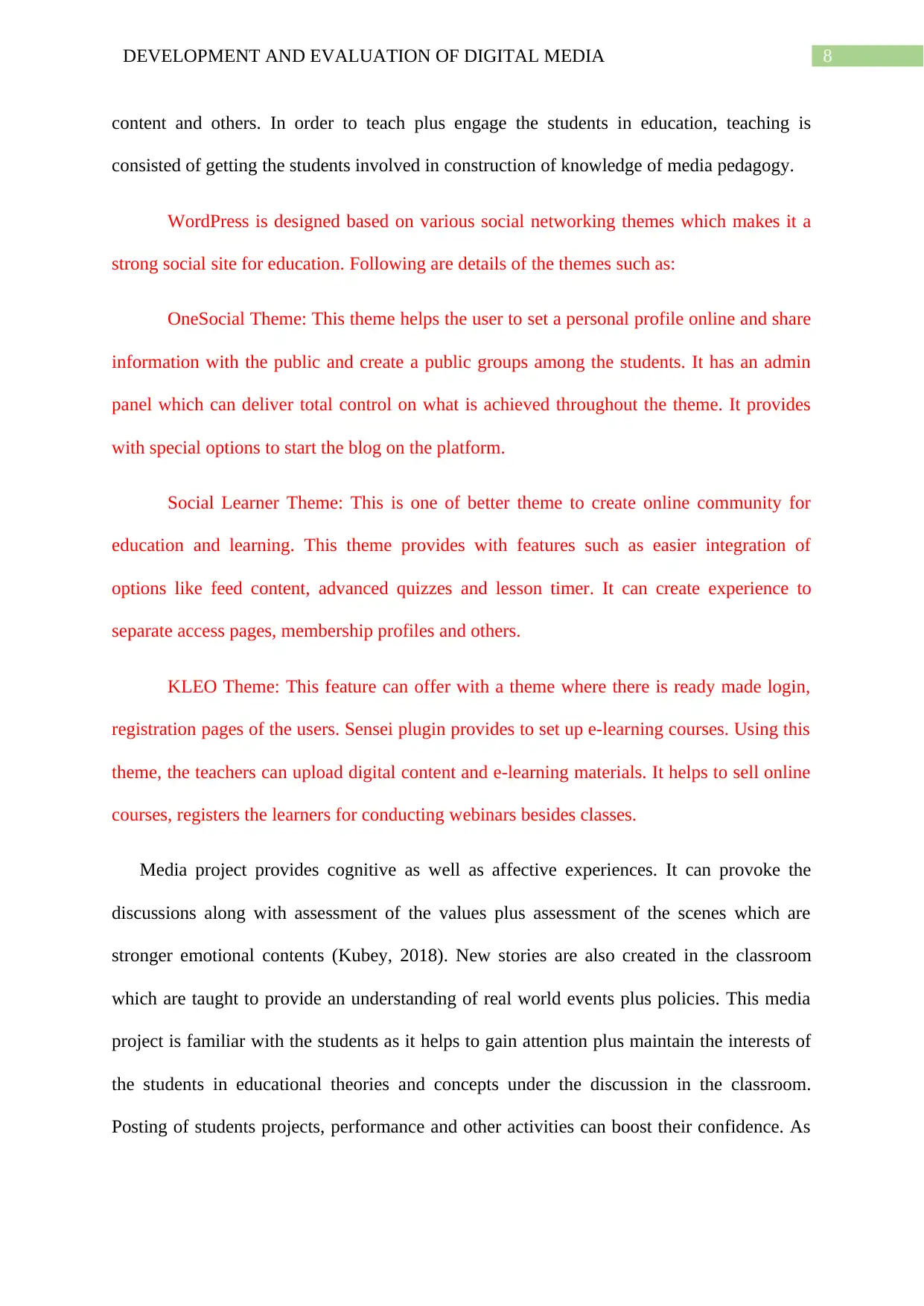
8DEVELOPMENT AND EVALUATION OF DIGITAL MEDIA
content and others. In order to teach plus engage the students in education, teaching is
consisted of getting the students involved in construction of knowledge of media pedagogy.
WordPress is designed based on various social networking themes which makes it a
strong social site for education. Following are details of the themes such as:
OneSocial Theme: This theme helps the user to set a personal profile online and share
information with the public and create a public groups among the students. It has an admin
panel which can deliver total control on what is achieved throughout the theme. It provides
with special options to start the blog on the platform.
Social Learner Theme: This is one of better theme to create online community for
education and learning. This theme provides with features such as easier integration of
options like feed content, advanced quizzes and lesson timer. It can create experience to
separate access pages, membership profiles and others.
KLEO Theme: This feature can offer with a theme where there is ready made login,
registration pages of the users. Sensei plugin provides to set up e-learning courses. Using this
theme, the teachers can upload digital content and e-learning materials. It helps to sell online
courses, registers the learners for conducting webinars besides classes.
Media project provides cognitive as well as affective experiences. It can provoke the
discussions along with assessment of the values plus assessment of the scenes which are
stronger emotional contents (Kubey, 2018). New stories are also created in the classroom
which are taught to provide an understanding of real world events plus policies. This media
project is familiar with the students as it helps to gain attention plus maintain the interests of
the students in educational theories and concepts under the discussion in the classroom.
Posting of students projects, performance and other activities can boost their confidence. As
content and others. In order to teach plus engage the students in education, teaching is
consisted of getting the students involved in construction of knowledge of media pedagogy.
WordPress is designed based on various social networking themes which makes it a
strong social site for education. Following are details of the themes such as:
OneSocial Theme: This theme helps the user to set a personal profile online and share
information with the public and create a public groups among the students. It has an admin
panel which can deliver total control on what is achieved throughout the theme. It provides
with special options to start the blog on the platform.
Social Learner Theme: This is one of better theme to create online community for
education and learning. This theme provides with features such as easier integration of
options like feed content, advanced quizzes and lesson timer. It can create experience to
separate access pages, membership profiles and others.
KLEO Theme: This feature can offer with a theme where there is ready made login,
registration pages of the users. Sensei plugin provides to set up e-learning courses. Using this
theme, the teachers can upload digital content and e-learning materials. It helps to sell online
courses, registers the learners for conducting webinars besides classes.
Media project provides cognitive as well as affective experiences. It can provoke the
discussions along with assessment of the values plus assessment of the scenes which are
stronger emotional contents (Kubey, 2018). New stories are also created in the classroom
which are taught to provide an understanding of real world events plus policies. This media
project is familiar with the students as it helps to gain attention plus maintain the interests of
the students in educational theories and concepts under the discussion in the classroom.
Posting of students projects, performance and other activities can boost their confidence. As
⊘ This is a preview!⊘
Do you want full access?
Subscribe today to unlock all pages.

Trusted by 1+ million students worldwide

9DEVELOPMENT AND EVALUATION OF DIGITAL MEDIA
for the teachers, they can use student portal Blackboard as a channel to store, read and present
the assignment details.
Students can see of educational theories plus concepts into actions (Greenhow & Lewin,
2016). By providing tools as well as methods will lead to understanding and building skills
required to participate and contribute towards the public debate. Media pedagogy is based on
the educational content, it has goal to memorize the events and evolution of the mass media
and develop of skills required to create presentation programmes.
4. Justification of choice of topic
This media project is selected for the study as we can get knowledge of using social
media for the educational purposes in the classroom. With increase of using social media for
learning purposes, we can also determine pedagogical knowledge of the teachers and students
in this course work. Due to implementation and evaluation of social media tools there is an
increase in learning which yields media pedagogical knowledge of the teachers and students
(Avila et al., 2016). Six critical success factors are identified for implementation of social
media tool such as WordPress which result in pedagogical changes. The factors are:
1. There is pedagogical integration of technology in student’s course as well as
student assessment. There is visual customization for easily create beautiful
assignments and courses.
2. Lecturer modelling is done by pedagogical using of the social media tools.
Lecture modelling is oral presentation for presenting information and teaching
the students on specific subjects.
3. Creating of supportive learning communities (Funk, Kellner & Share, 2016).
4. Each of the student can provide own dashboard which allow them to track
their own progress throughout entire course.
for the teachers, they can use student portal Blackboard as a channel to store, read and present
the assignment details.
Students can see of educational theories plus concepts into actions (Greenhow & Lewin,
2016). By providing tools as well as methods will lead to understanding and building skills
required to participate and contribute towards the public debate. Media pedagogy is based on
the educational content, it has goal to memorize the events and evolution of the mass media
and develop of skills required to create presentation programmes.
4. Justification of choice of topic
This media project is selected for the study as we can get knowledge of using social
media for the educational purposes in the classroom. With increase of using social media for
learning purposes, we can also determine pedagogical knowledge of the teachers and students
in this course work. Due to implementation and evaluation of social media tools there is an
increase in learning which yields media pedagogical knowledge of the teachers and students
(Avila et al., 2016). Six critical success factors are identified for implementation of social
media tool such as WordPress which result in pedagogical changes. The factors are:
1. There is pedagogical integration of technology in student’s course as well as
student assessment. There is visual customization for easily create beautiful
assignments and courses.
2. Lecturer modelling is done by pedagogical using of the social media tools.
Lecture modelling is oral presentation for presenting information and teaching
the students on specific subjects.
3. Creating of supportive learning communities (Funk, Kellner & Share, 2016).
4. Each of the student can provide own dashboard which allow them to track
their own progress throughout entire course.
Paraphrase This Document
Need a fresh take? Get an instant paraphrase of this document with our AI Paraphraser
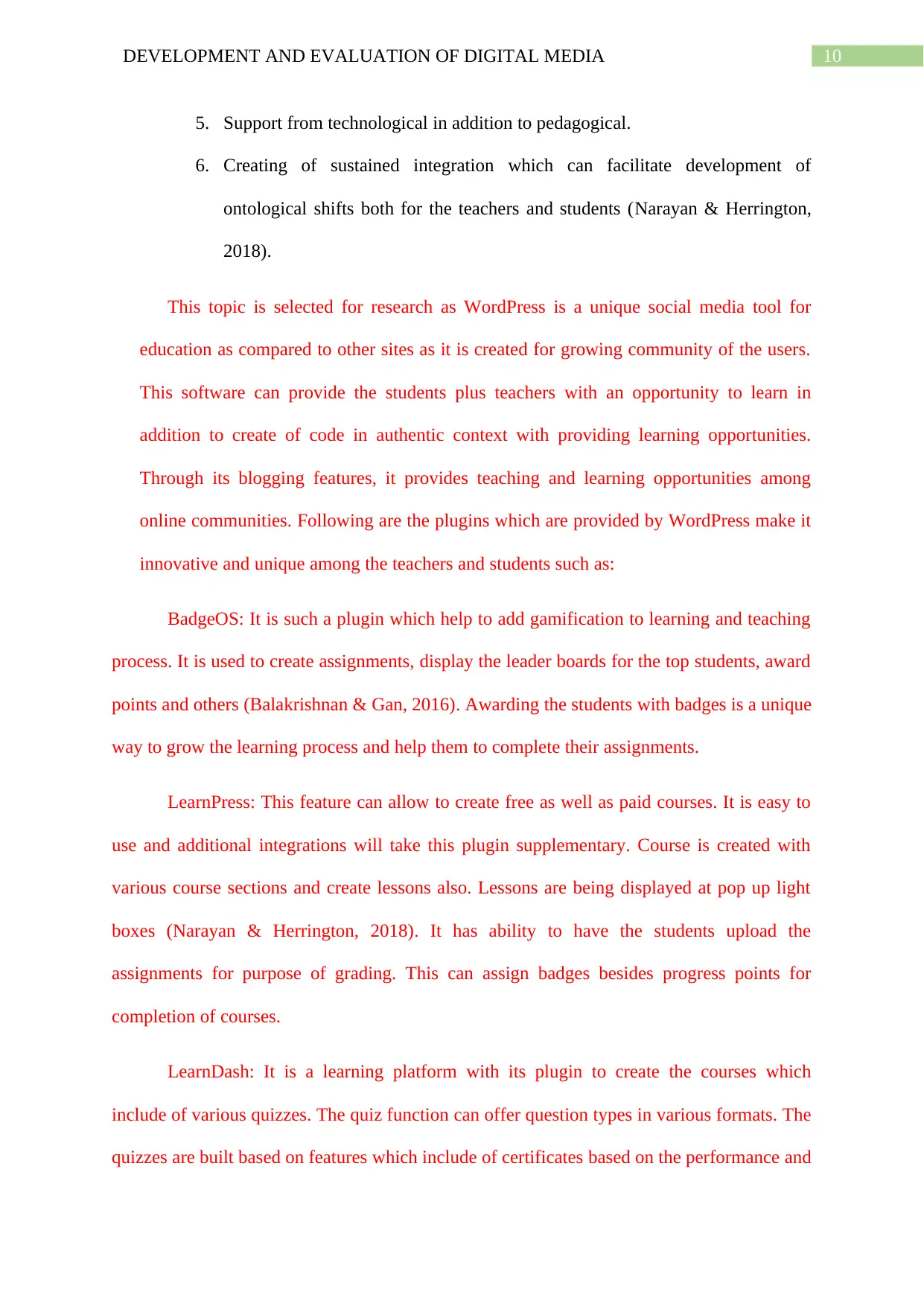
10DEVELOPMENT AND EVALUATION OF DIGITAL MEDIA
5. Support from technological in addition to pedagogical.
6. Creating of sustained integration which can facilitate development of
ontological shifts both for the teachers and students (Narayan & Herrington,
2018).
This topic is selected for research as WordPress is a unique social media tool for
education as compared to other sites as it is created for growing community of the users.
This software can provide the students plus teachers with an opportunity to learn in
addition to create of code in authentic context with providing learning opportunities.
Through its blogging features, it provides teaching and learning opportunities among
online communities. Following are the plugins which are provided by WordPress make it
innovative and unique among the teachers and students such as:
BadgeOS: It is such a plugin which help to add gamification to learning and teaching
process. It is used to create assignments, display the leader boards for the top students, award
points and others (Balakrishnan & Gan, 2016). Awarding the students with badges is a unique
way to grow the learning process and help them to complete their assignments.
LearnPress: This feature can allow to create free as well as paid courses. It is easy to
use and additional integrations will take this plugin supplementary. Course is created with
various course sections and create lessons also. Lessons are being displayed at pop up light
boxes (Narayan & Herrington, 2018). It has ability to have the students upload the
assignments for purpose of grading. This can assign badges besides progress points for
completion of courses.
LearnDash: It is a learning platform with its plugin to create the courses which
include of various quizzes. The quiz function can offer question types in various formats. The
quizzes are built based on features which include of certificates based on the performance and
5. Support from technological in addition to pedagogical.
6. Creating of sustained integration which can facilitate development of
ontological shifts both for the teachers and students (Narayan & Herrington,
2018).
This topic is selected for research as WordPress is a unique social media tool for
education as compared to other sites as it is created for growing community of the users.
This software can provide the students plus teachers with an opportunity to learn in
addition to create of code in authentic context with providing learning opportunities.
Through its blogging features, it provides teaching and learning opportunities among
online communities. Following are the plugins which are provided by WordPress make it
innovative and unique among the teachers and students such as:
BadgeOS: It is such a plugin which help to add gamification to learning and teaching
process. It is used to create assignments, display the leader boards for the top students, award
points and others (Balakrishnan & Gan, 2016). Awarding the students with badges is a unique
way to grow the learning process and help them to complete their assignments.
LearnPress: This feature can allow to create free as well as paid courses. It is easy to
use and additional integrations will take this plugin supplementary. Course is created with
various course sections and create lessons also. Lessons are being displayed at pop up light
boxes (Narayan & Herrington, 2018). It has ability to have the students upload the
assignments for purpose of grading. This can assign badges besides progress points for
completion of courses.
LearnDash: It is a learning platform with its plugin to create the courses which
include of various quizzes. The quiz function can offer question types in various formats. The
quizzes are built based on features which include of certificates based on the performance and

11DEVELOPMENT AND EVALUATION OF DIGITAL MEDIA
leaderboard of the students. Using this plugin, the teacher can get detailed information about
each student’s performance.
5. Target group
The target group for this media project is consisted of trained pedagogues, teachers
and students from the vocational as well as primary schools. As the social media
education is a pedagogical approach towards earlier childhood of education, therefore the
target group is only limited to those who are involved in social media education purposes.
This media project is intended to provide target group with an overview of the new media
topic so that they can understand the purpose of this media project (Narayan &
Herrington, 2018). The aim is to analyse role of pedagogical approach for increasing
learning yield of the media pedagogical knowledge of the teachers and students.
Following are competences on which the entire study is aimed at such as following:
1) The target group should know most of the aspects of media pedagogy in the
educational purposes.
2) Media pedagogy is considered by the target group such as the students and
teachers in educational field.
3) Groups of people from the target group should able to use of the pedagogy
within a professional contexts.
From the entire study, it is determined that the target group is interested in the study
as it can yield an increase of media pedagogical knowledge among the students and teachers.
There is total of five teacher training students from the University and five teachers took part
in the study. Among the ten participants, six of them are female while others are male. All the
participants are among age of 21-50 years old. The teachers those are participated in the study
have a media-related teaching style. The teacher training students are taken from various
leaderboard of the students. Using this plugin, the teacher can get detailed information about
each student’s performance.
5. Target group
The target group for this media project is consisted of trained pedagogues, teachers
and students from the vocational as well as primary schools. As the social media
education is a pedagogical approach towards earlier childhood of education, therefore the
target group is only limited to those who are involved in social media education purposes.
This media project is intended to provide target group with an overview of the new media
topic so that they can understand the purpose of this media project (Narayan &
Herrington, 2018). The aim is to analyse role of pedagogical approach for increasing
learning yield of the media pedagogical knowledge of the teachers and students.
Following are competences on which the entire study is aimed at such as following:
1) The target group should know most of the aspects of media pedagogy in the
educational purposes.
2) Media pedagogy is considered by the target group such as the students and
teachers in educational field.
3) Groups of people from the target group should able to use of the pedagogy
within a professional contexts.
From the entire study, it is determined that the target group is interested in the study
as it can yield an increase of media pedagogical knowledge among the students and teachers.
There is total of five teacher training students from the University and five teachers took part
in the study. Among the ten participants, six of them are female while others are male. All the
participants are among age of 21-50 years old. The teachers those are participated in the study
have a media-related teaching style. The teacher training students are taken from various
⊘ This is a preview!⊘
Do you want full access?
Subscribe today to unlock all pages.

Trusted by 1+ million students worldwide
1 out of 16
Related Documents
Your All-in-One AI-Powered Toolkit for Academic Success.
+13062052269
info@desklib.com
Available 24*7 on WhatsApp / Email
![[object Object]](/_next/static/media/star-bottom.7253800d.svg)
Unlock your academic potential
Copyright © 2020–2025 A2Z Services. All Rights Reserved. Developed and managed by ZUCOL.





